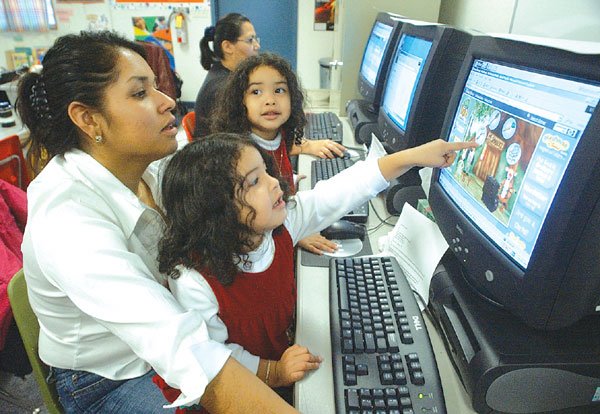GILROY
– Norma Peredia uses a computer at Glen View Elementary School
to help her twin daughters learn to count.
”
Rabbit,
”
a character from A.A. Milne’s beloved Winnie the Pooh stories,
prompts Peredia to pick an item from a series of icons.
By Lori Stuenkel
GILROY – Norma Peredia uses a computer at Glen View Elementary School to help her twin daughters learn to count. “Rabbit,” a character from A.A. Milne’s beloved Winnie the Pooh stories, prompts Peredia to pick an item from a series of icons. She clicks on an egg. Out of a barrel on the screen fly three eggs, and letters below spell out “E-G-G-S.” Peredia’s daughters “oohh” and “aahh” and point at the screen.
Two computers down, Angelica Davila types a sample business letter using a word processor as her 2-year-old daughter quietly leans against her leg. The practice will help her communicate with professionals, such as an employer or teacher, and become familiar with the computers her children will use at school.
The parents and children are learning life-long skills that will better prepare the children for kindergarten – which, studies say, will lead to continued academic success – in a “Parent and Me” computer course offered through First 5. The state-funded program links Gilroy Unified School District with more than a dozen education and health agencies.
“The overarching goal is to improve the quality of parenting as well as having children healthy and ready to enter school, in order to improve their success,” said Debra Aboytes, GUSD’s Early Childhood Education administrator.
The computer course, provided through the GUSD’s Adult Education, is just one example of the classes available to families at no cost through First 5.
The program serves children, newborn to age 5, and their parents. The idea is to help students achieve in school well before their first day of class.
Care managers refer families to services offered through partner agencies, including Gilroy Community Services, Saint Joseph’s Family Center, the Mexican American Community Services Agency and the Gilroy Nutrition Task Force.
“So we look at it multifaceted in terms of the physical health of the child, as well as the mental health of the child and the educational health. We also look at the whole family and not just the child,” Aboytes said.
In order to be eligible for First 5 services, parents need to live in one of four district attendance areas: Antonio Del Buono, Las Animas, Glen View and Eliot. The schools qualify to receive funding because of their low standardized test scores at the time of the grant submission.
This is the second of four years that GUSD will receive $543,620 from a Santa Clara County grant, which covers instructional, case management, outreach and administrative costs.
Six care managers act as liaisons for 299 First 5 families. To recruit families, the care managers travel door to door in each attendance area. According to GUSD data, care managers have knocked on more than 6,000 doors and identified 913 families eligible for First 5 since June.
Following interviews, families are referred to various educational or health services, such as a public health nutritionist or Head Start, a state preschool program.
“People sometimes will sign up, and then they don’t follow through,” Aboytes said. “We’re here to encourage and support.”
Also, this year, the program will serve students up to age 6, whereas last year the cutoff was 5 years old. The change allows First 5 to assist families until their children enter kindergarten, particularly those born after the district’s kindergarten enrollment cutoff date, Dec. 2.
That’s another eight months of services for children not yet in kindergarten.
In the computer class, Lorena De La Torre, who attends while her son is at preschool, practices her keyboarding. She said using the computers gives her an opportunity to improve her skills and set an example for her son.
“I know that I’ll learn new things, ” said De La Torre, who also works full time.
Her son often comes home from preschool confused because he must speak English the entire time.
“I told him, ‘You have to learn,’ ” De La Torre said. She speaks from experience, having taken English classes at Gavilan College.
Davila, who was learning how to type a business letter at the class, said she also attends English classes and a weekend family program.
“We learn everything about how to care for (our children) and keep them safe … and also how to prevent accidents inside the home and outside the home,” said Davila, who speaks only Spanish.
Davila has also learned about children’s developmental stages, she said. In the computer class, she is gaining more high-tech experience.
The parents research everything from educational Web sites to favorite recipes, said Annette Hernandez, who teaches the computer class.
“Many of them here don’t have the privilege or ability of using the computer at home, so this is really a benefit,” Hernandez said.
The program is based out of four “family academies” located at each of the four eligible schools. The Lucile and David Packard Foundation provided a grant last year to purchase portables for three of the sites. Las Animas does not have a portable because the school is due to be torn down; an empty classroom is used instead. When the school is demolished in 2005, the program will be based out of ADB. Families in the Eliot area go to South Valley, since that school will also be demolished.












